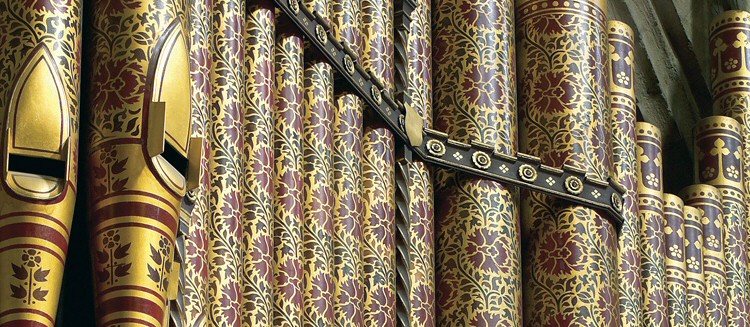The Cathedral Organs
Durham Cathedral has the advantage of two organs; the main organ and the Laus Deo organ. The main cathedral organ was built by Henry Willis I (Father Willis) in 1876/77, the same year as that at Salisbury Cathedral, with which it had much in common. Willis was the greatest British organ-builder of his day; but the placing of the instrument on both sides of the quire stretched the available technology to the limit, and by the turn of the twentieth century much of the north side (the side opposite the console) was unplayable. In 1905 Harrison & Harrison of Durham were commissioned to rebuild the instrument, thus beginning an association which has lasted a century. As well as restoring it to working order they revoiced Willis’ work considerably, also preparing for major additions, whose completion financial constraints caused to be delayed until 1935.
In 1970, towards the end of Conrad Eden’s distinguished tenure of the post of Organist, Harrison & Harrison again rebuilt the instrument, installing a new console and making further significant additions which while in keeping with the ideas of the time also respected the integrity of the existing instrument. Further housekeeping work, as well as a few more developments, have now left the organ fit for service in its third century. It has four manuals (controlling five manual divisions) and pedals; 98 speaking stops and 23 couplers and accessories; and 5,746 pipes.
No mere figures, however, can do justice to its sound or to its effect in the building. Concept, design, placing, voicing and environment combine to make it one of the most triumphantly successful organs of the English-speaking world, a legend in its own lifetime. Several recordings are available; but there is no substitute for listening to it live in the building, where almost daily it continues to fulfil its roles of accompanying choir and congregation and adorning the liturgy through solo repertoire.

Laus Deo Organ
In 2004 the Cathedral took delivery of a brand new organ funded by a large gift to the DCCA by David Boardman. The instrument is a small chamber organ built by Lammermuir Pipe Organs from Oldhamstocks in the Lammermuir Hills south of Edinburgh. The firm is run by Neil Richerby who learned his trade in Europe and Canada and who specialises in building instruments along historical lines using traditional methods. The new organ brings to life the sound-world of the seventeenth century and its woodwork picks up themes from the black oak Cosin choirstalls and from the Father Smith organ.
The organ’s primary use is in accompanying pieces written in the seventeenth and eighteenth centuries; it has four stops: a Stopped Diapason (8’), made from oak and walnut, a Principal (4’) made of 25% tin, a Nason Flute (4’) of oak, maple and walnut, and a wooden Fifteenth (2’), of maple and pine. A pedal controls a simple mechanism which makes it possible to silence all except the 8-foot stop (very useful when both hands are busy). Most of the organ is made of oak, but the keyboard has cowbone naturals and ebony sharps. It is moveable, on wheels which retract so that the instrument stands solidly on its own base once in position.

